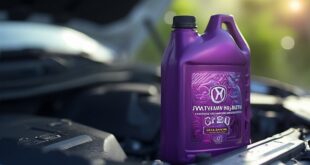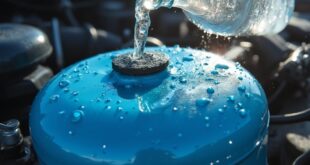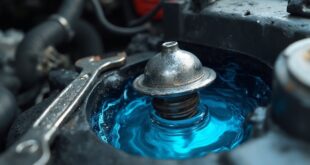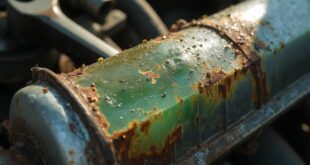Bubbles in the coolant reservoir can arise from several factors. Common causes include a broken pressure cap that allows air to enter the system, a blown head gasket leading to coolant leaks and combustion chamber contamination, or air pockets formed after a coolant flush. Additionally, a malfunctioning thermostat might contribute to overheating and excessive bubbling. Understanding these issues can be essential for maintaining engine health, as further details reveal more about effective cooling system management.
Understanding the Cooling System Components
The car cooling system is an important assembly designed to regulate engine temperature and prevent overheating. It comprises several key components, including the water pump, thermostat, radiator, and pressure cap.
The water pump circulates coolant to absorb heat from the engine, while the thermostat guarantees the coolant remains within an ideal temperature range.
The radiator plays a critical role by dissipating heat from the hot coolant using outside air before it re-enters the engine.
This continuous loop of coolant circulation is necessary for maintaining efficient engine performance and safeguarding against potential overheating, promoting the overall health of the vehicle's engine.
Normal vs. Excessive Bubbles in the Coolant Reservoir
While small bubbles in the coolant reservoir can be a normal occurrence during coolant circulation, excessive bubbling often signals potential issues within the cooling system.
A few bubbles during coolant top-up may not indicate a problem, especially if the engine remains at a stable temperature. However, excessive bubbles, particularly alongside overheating, can suggest significant system failures.
It is vital to monitor both coolant levels and temperature fluctuations, as these factors help differentiate between normal and excessive bubbling.
Regular inspections can guarantee the cooling system's health, preventing minor issues from escalating into major repairs.
Identifying the Causes of Bubbles
Bubbles in the coolant reservoir can arise from various underlying issues within the car's cooling system. A broken pressure cap may allow air to enter, creating bubbles.
Additionally, a blown head gasket can cause a loss of air pressure, affecting the coolant's boiling point. Air pockets trapped after a coolant flush may also contribute to bubbling.
Coolant leaks can introduce air, while a malfunctioning thermostat may lead to overheating and excessive bubbles.
Moreover, issues such as a defective water pump or contaminated coolant can exacerbate the problem, necessitating thorough inspection and maintenance to identify and resolve these causes.
The Impact of a Broken Pressure Cap
A broken pressure cap can greatly disrupt the functionality of a car's cooling system.
This vital component is designed to maintain the system's pressure, which prevents coolant from boiling and allows for effective heat exchange. When compromised, the cap permits air to infiltrate the cooling system, leading to the formation of bubbles in the coolant reservoir.
This influx of air can reduce the coolant's effectiveness, resulting in overheating and potential engine damage. Additionally, the presence of excessive bubbles may hinder proper circulation, further exacerbating cooling issues.
Regular inspections and timely replacement of the pressure cap are essential for ideal performance.
Recognizing Signs of a Blown Head Gasket
Failure of the pressure cap can lead to significant cooling system issues, including the possibility of a blown head gasket.
Signs of a blown head gasket can manifest in various ways. White smoke from the exhaust, indicative of coolant entering the combustion chamber, is a primary symptom. Additionally, oil contamination in the coolant reservoir may signal a breach in the gasket.
Drivers may also notice coolant mixing with engine oil, resulting in a milky substance. Unusual engine noises or a drop in power can further suggest gasket failure.
Prompt recognition of these signs is essential for preventing severe engine damage.
Diagnosing Air Pockets in the Cooling System
How can one effectively diagnose air pockets in a vehicle's cooling system?
First, observe the coolant reservoir for excessive bubbles without overheating, which could suggest trapped air. A temperature gauge reading higher than normal may also indicate circulation issues.
Next, check for leaks or a malfunctioning pressure cap that might introduce air.
Bleeding the cooling system can help release trapped air; this process typically involves locating the bleed valve and running the engine while topping off coolant.
Regular inspections of coolant levels and components can aid in early detection of air pockets and prevent further complications.
Preventative Measures to Maintain Coolant Health
To guarantee the longevity and efficiency of a vehicle's cooling system, regular maintenance of coolant health is essential.
Vehicle owners should routinely check and maintain coolant levels to avoid overheating and system damage. Inspecting the head gasket and ensuring the radiator cap functions properly helps maintain system pressure.
Flushing the coolant system as per manufacturer recommendations prevents contamination buildup. It is vital to monitor for any oil contamination in the coolant reservoir, as this may signal underlying issues.
Frequently Asked Questions
Can I Drive With Bubbles in the Coolant Reservoir?
Driving with bubbles in the coolant reservoir may not be immediately problematic. However, if excessive bubbling occurs alongside overheating or other symptoms, it could indicate underlying issues requiring prompt attention to avoid potential engine damage.
How Often Should I Check My Coolant Level?
To guarantee peak vehicle performance, checking coolant levels should occur at least monthly. Additionally, it's advisable to inspect levels before long trips or after significant temperature changes to prevent potential overheating and maintain engine health.
What Type of Coolant Is Best for My Vehicle?
The ideal coolant type for a vehicle depends on manufacturer specifications, often indicated in the owner's manual. Common options include ethylene glycol-based and propylene glycol-based coolants, each offering varying protection and temperature resistance for engine health.
Are Bubbles in the Coolant Harmful to My Engine?
Bubbles in the coolant can be harmless if not accompanied by overheating. However, excessive bubbles may indicate underlying issues, potentially leading to engine damage. Regular monitoring is vital to guarantee ideal cooling system performance and engine health.
How Can I Tell if My Coolant Is Contaminated?
To determine coolant contamination, one should check for discoloration, oil presence, or an unusual odor. Additionally, inspecting for debris or particles within the coolant can indicate potential issues affecting the vehicle's cooling system performance.
 Car Service Land Coupons for Oil change, Tires, Wheel alignment, Brakes, Maintenance
Car Service Land Coupons for Oil change, Tires, Wheel alignment, Brakes, Maintenance




